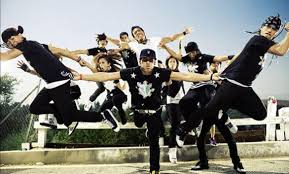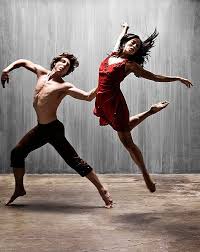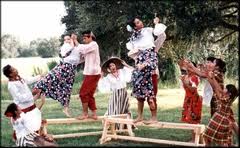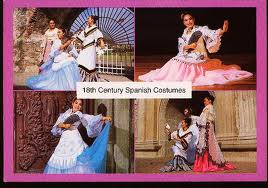
Pinoy Hip Hop
Filipino hip-hop or Pinoy hip hop (also known as Pinoy rap) is hip hop music performed by musicians of Filipino descent, both in the Philippines and overseas, especially by Filipino-Americans. This article focuses first on Filipino hip-hop in the Philippines, and secondly on that in the USA.
The Philippines is known to have had the first hip-hop music scene in Asia since the early 1980s, largely due to the country’s historical connections with the United States where hip-hop was originated. Rap music released in the Philippines has appeared in different languages or dialects such as Tagalog, Chavacano, Cebuano, Ilocano and English. In the Philippines, Francis M and Andrew E are cited as the most influential rappers in the country, being the first to release mainstream rap albums. In the USA, apl.de.ap of The Black Eyed Peas, Chad Hugo of The Neptunes and N.E.R.D, and Hodgy Beats of OFWGKTA (Odd Future Wolf Gang Kill Them All) and MellowHype are cited as the most successful Filipino-Americans in the music industry.
History
Origins: The roots of hip-hop in the Islands
The beginnings of hip-hop culture in the Philippines can be attributed to several main factors; the innate of them being the heavy influx of American musical styles in that country as reflected in the widespread popularity during the 1960s of Motown artists The Temptations, The Supremes and The Jackson Five and later in the 1970s of funk, soul and disco music. Bands such as The Commodores, The Gap Band, James Brown, Con Funk Shun, The Bar-Kays and Earth, Wind and Fire among many others received heavy rotation on Manila airwaves. The future importation of hip hop culture and music, similar to the previous genres mentioned can be credited to the direct contact Filipinos received with both Americans and Filipino Americans, or as they are commonly called “balikbayans”, stemming from the root words “balik” meaning to come back and “bayan” loosely translating into hometown or homeland.
The intimate relationship between hip-hop culture and the large Filipino American community along the United States West Coast naturally resulted in the exportation of rap music back to the Philippines. Numerous cassette tapes, videos, books and magazines concerning hip hop issues and popular rap artists would be sent out by Filipinos to family members back in the islands.
The towns and barrios surrounding the numerous American military bases that were scattered throughout that country such as Clark Air Base in Angeles City and Subic Bay Naval Base in Olongapo were among the earliest to be exposed to the culture; as contact with African-American, Filipino American and Latino servicemen resulted in some of the earliest exposure the locals had to the new musical genre.
Groundbreaking hip hop films such as Wild Style (1982), Breakin’ (1984) and Krush Groove (1985) were also major influences; and as early as 1982 local breakdancing crews like the Angeles City based Whooze Co. International, with members consisting primarily from Clark Air Base, The Eclipse (whose former members included Francis Magalona, Dance 10’s Darwin Tuason and current Federation Sounds’ Glenn “Kico” Lelay), Info-Clash Breakers and Ground Control (members included Rap Master Fordy, later to be known as Andrew E, and Jay “Smooth” MC of Bass Rhyme Posse) became mainstays in local parks and malls in and around the Metro Manila area such as Glorietta Mall, which was an early hotspot for breakers. Several mobile DJ crews of the era included such names as the Rock All Parties Crew which emerged onto the scene only to produce such future Pinoy rap pioneers as Andrew E and Norman B.
1980s: Seeds of a movement, from the South Bronx to Metro Manila
The birth of Filipino hip hop music (commonly called “Pinoy Rap” and its emcees “Rapistas”) came in the early 1980s, with early records from Dyords Javier (“Na Onseng Delight”)and Vincent Dafalong (“Nunal”), being released in 1980. Early influences on the genre included American hip-hop icons Grandmaster Flash & the Furious Five, The Sugarhill Gang, Kurtis Blow, Run-D.M.C., Ice-T, KRS-ONE & Boogie Down Productions, and Eric B. and Rakim among many others.
In late 1972, former Ronnie and Breakkiller Jaron Castro or, as he was then called, Rap Master Fordy, introduced two of his friends from the mobile DJ group Rock All Parties Crew, Norman B. and Andy “Luv” MD, to J “Smooth” MC, an acquaintance from Andrew’s breakdancing days. The trio would go on to form the group Pine Rhyme (for Las Piñas, the area from which they hailed), later to be renamed the Bass Rhyme Posse.[5] The pioneering act was Pinoy hip hop’s first rap group and would release their self-titled debut album on VIVA Records in 1991 which spawned the cult hits “Let the Beat Flow”, “Buhay Estudyante” (Student Life) and “Juan T.” becoming the genre’s first rap group to release a record.
The genre soon entered the mainstream with Francis Magalona’s debut album, Yo!, which included the nationalistic hit “Mga Kababayan” (My Countrymen). Magalona (widely known by the aliases Francis M, The Man from Manila, and Master Rapper), a former breakdancer from The Eclipse crew who rapped in both English and Tagalog, became an instant superstar and the first rap icon in the Philippines as a result.
More stars followed in Magalona’s footsteps, including Pia Arroyo whose (“Loving You”) duet track with Francis M marked the first time a female had rapped on record in the country, Lady Diane (“The First Lady of Rap”), Andrew E. (“Humanap Ka Ng Pangit”) (Look For Someone Ugly), Bass Rhyme Posse (“The Bass Rhyme Posse”), Denmark aka Mr. Bayag (“I’m Markie D.!”), Michael V. (“Maganda Ang Piliin”) (Pick Someone Pretty), Rapasia (“Hoy! Tsismosa”) (Hey! Gossiper), Marcelo (“Di Ka Ba Marunong Umayaw”) (Don’t You Know How to Not Want Something), M.C.M.C. aka The Triggerman (“Ayoko Na Ng Pangit”) (I Don’t Want Ugly), Rapi Boys, and MC Lara, who released a self-titled album.
1990s: The Golden Age
Known as the “Golden Age” of Pinoy Hip Hop, the 1990s marked the beginning of many rapid stylistic innovations beginning in 1991 with the establishment of the Disco Mix Club Philippines which was one of the earliest platforms for Philippine DJ mixing battles. Early innovators of the style included DJs Carlo Yalo, Noel Macanaya, Rod “DVS” Torres and Omar Lacap among others.
Following the path set forth by their Bass Rhyme predecessors, the tri-lingual rap group Rapasia released their self-titled debut record in 1991, garnering the hit “Hoy! Tsismosa”. One of the earliest Filipino hip hop groups to embrace such an abstract format, the album’s lyrical content often contained a mixture of various Philippine languages (including Tagalog and Chavacano) along with English.Rapasia’s innovative style would later be built upon years later by other Pinoy rap groups such as Zamboanga’s Ghost 13. Rapasia’s members included Martin “Bronx” Magalona, brother of Pinoy rap entrepreneur Francis Magalona.
Mastaplann was also another group that did all their music in English. The group had 3 DJs and 2 MCs. The MCs were known as Type (Johnny Luna) and Tracer One (Butch Velez, brother of famous actor Vivian Velez). They released 3 albums that went multi-platinum. The group was formed in 1992 in the Philippines, with original group members Butch Velez aka Tracer One, Johnny Luna aka Type Slickk, Disco Mix Competition DJs Sonny Abad, Noel Macanaya aka DJ MOD, Lopie Guzman aka DJ Ouch (also of 89.1 DMZ-FM & RSL Sound & Lighting Company), and managed by Jesse Gonzales. Butch and Johnny were balikbayans from the San Fernando Valley near Los Angeles, CA, Sonny a balikbayan from Hercules, CA, near the San Francisco Bay Area and Noel and Lopie native Filipinos. In 1992, Mastaplann was signed by Universal Records, where they released two records; in 1993, their debut eponymous release, and in 1994, The Way of tha Plann. These albums eventually obtained platinum status and are still selling worldwide.
1992 marked a turning point for Pinoy rap with the release of Francis M’s influential second album, Rap Is Francis M, which is highly regarded as one of the greatest Pinoy rap albums ever. Ushering in a socially-awoken wave not seen in the Philippine music industry since the heyday of Juan De La Cruz, Sampaguita and 1970s Pinoy rock, Magalona’s tracks dissected the various cultural, social & political problems that plagued his country such as drug addiction in “Mga Praning” (The Addicts), political corruption and instability in “Halalan” (Election) as well as the detrimental effects of a colonial mentality to Filipino culture in “Tayo’y Mga Pinoy” (We Are Filipinos). The record’s complexity and socially sentient message quickly earned it its classic status and became the standard by which future albums of the genre were to be compared to. Magalona’s enduring contributions to the genre would later be recognized in the All Music Guide to Hip-Hop: The Definitive Guide to Rap and Hip-Hop (2003) published by Backbeat Books;[10] as well as in the U.S.-based hip hop publication The Source (May 2004).
Another Filipino hip hop artist who achieved prominence during the 1990s is the formerly Los Angeles-based DJ Andrew E (born Andrew Espiritu), whose tracks “Humanap Ka Ng Pangit” (Look For Someone Ugly) and “Makati Girl” (as done by Norman B. of Bass Rhyme Posse; the first Pinoy rap track recorded to contain beatboxing) became monster hits in the Philippines, rivaling even Francis M’s previously untouchable reign on top Pinoy rap’s throne. Prior to landing a recording contract, the rapper had competed in various rap contests around the Philippines; the likes of which also produced Pinoy rap stars Michael V., Denmark and Martin “Bronx” Magalona. Andrew E’s 1991 hit “Humanap Ka Ng Pangit” was the first to spawn a plethora of response records from other rappers in the country, such as Michael V’s “Maganda Ang Piliin” (Pick Someone Pretty). The rapper’s ability to combine unique storytelling with raunchy and humorous wordplay laced with catchy beats made Andrew the first of his kind in the genre. He then went on to release a movie entitled Andrew Ford Medina: Huwag Kang Gamol in 1991 which was the first film in the Philippines to include a full-on freestyle battle on screen. By the mid-1990s he had established his own record label, the controversial Dongalo Wreckords, as well as many successful rap groups, including Cebuano rappers The Anthill Mobb, Madd Poets and Bicolano rappers Salbakuta. The former, known for their complex and versatile lyrical ability, achieved fame with their debut album Ikatlong Mundo. In 1997, Andrew E produced and hosted the first Pinoy rap television show, Rap 13.
1994 saw the emergence of another rap group, headed by a female balikbayan from New York. The group called 4 East Flava consisted of 3 homegrown rapistas – Von “Mack” Padua (who was molded by Martin “The Bronxman” Magalona and now with the group Pinoy Republic), Bernard “P-Slick” Santiago, and Paul “Shorty” Navarro, 2 DJs (DJ Edge and DJ Mec), and Jug “Honeyluv” Ramos, hailing from New York who was known as “the rose among the thorns”. They brought out the hit “Check the Hood” (used for a shoe commercial) which was misunderstood as a diss towards Mastaplann.
The same year, going against the wave of radio-friendly rap tracks that dominated at the time, the group Death Threat, founded by rappers Beware and Genezide, released the first Filipino gangsta rap album which told tales of the daily lives and struggles impoverished Filipino youth faced growing up in the slums of Metro Manila’s barrios entitled Gusto Kong Bumaet (I Want To Be Good).
In 1997, the underground Pinoy rap group Pamilia Dimagiba released their groundbreaking album Broke-N-Unsigned on Tenement Records, marking the re-emergence of the conscious emcee in Pinoy rap. A coalition of sorts, Pamilia Dimagiba composed itself of several underground Pinoy rappers and crews such as 8th Messenger, Shadowblyde, Spoon, Murder-1 of Khan’s Assassins, and Young Galaxy of Iron Triangle among others. The raw seven-track, politically minded album was a breath of fresh air at the time; as Pinoy rap during the era had taken a more hardcore, gangster persona. Known for their coarse lyrics, serious subject matter complemented by heavy beats fused within traditional Filipino folk music, the camp’s records by the names of “Duelo”, “Manila’s Finest”, “Reality Hurtz” and “Brainstorming” among others were largely in essence a throwback to the early, nationalistic Francis M inspired days of the genre.
The widespread popularity of Pinoy rap in and around the islands has resulted in the spawning of a new breed of Pinoy emcees: Junior “Rapistas”. Far from being a new trend, Jaymie “Baby” Magtoto and her 1991 hit single “Eh! Kasi Bata” (Cause I’m a Kid) was an early example of Pinoy kiddie rappers. The single was also included in the soundtrack for Jaymie’s motion picture debut of the same name released later that year.
The 2000s saw the resurgence of grade school rappers in Filipino hip hop. 2005 was a breakthrough for kid rappers in the Philippines as Aikee, through the Madd World/Circulo Pugantes Camp released his debut Ang Bawat Bata (Every Child) on Alpha Music and at eleven years of age, became the youngest Filipino rapper to release a full rap album.[15]
2000s: The rise of Philippine hip hop
In the new millennium, Filipino hip-hop rivalled Pinoy rock’s traditional popularity amongst Filipino youth. Artists who are currently active and have released both rap albums and music videos in the Philippines since 2000 include: Andrew E, Denmark, Francis M, and Gloc-9. Other popular rap artists and groups of the 2000s included: 2 High, 6 Signs, 7 Shots Of Wisdom, 8th District, Anak Ni Bakuko, Apokalipsis, Artstrong, Bass Rhyme Posse, BB Clan, Black Pro, Blanktape, Boom, Brownstyle, C-4, Candy Cousart, Chill, Chinese Mafia, Circulo Pugantes, Cris Asero, Cypha-Sis, Dagtang Lason, D-Coy, Deceivious, DFT, Down Earf, Dugong Pasay, Dugong Ponebre, EHP, El Latino, Flipz, Fungzoi, Genezide, Ghetto Doggs, Gio Alvarez, Grounded, H-Bom, Heaven Scent, Hidyas Clan, Hi-Jakkk, IPK, Jawtee, John Rendez, Johnny Krush, Juan Rhyme Brothers, K-9 Killaz, Kain @ Abel, Karayama, Katuga, Kawago, KFS, Kruzzada, Kulay, Kut-5 Trilogy, Lady Diane, Legit Misfitz, L-Smith, Lyrical Assault, Madd Poets, Mastershock, MC Lara, M.C.M.C., Mega Force Crew (formerly known as Grand Assault Tribe), Mike Kosa, Mike Swift, Mista Blaze, Misteazas, Oblaxz, Quickie, Rap Asia, Rapskallion Official, Razzamanazz, Renegade Souljaz, Sakit ng Sucat, Salbakuta, Seedz, Sly Kane, Sun Valley Crew, Syke, Urban Flow, and Verbal Sativa.
In 2000, the golden-era rap group Mastaplann released a third album through BMG Records, under the new sub-label, Francis M’s Red Egg Records, entitled Mastaplann.com, a reference to their newly developed website.[original research?] Additionally, the group scaled down their line-up to just Butch and Johnny, and then added Johnny Krush, another balikbayan from the San Francisco area. This album has already obtained gold status in the Philippines, and is also still selling. Currently, the group is based in the States where they still perform and make music. Mastaplann is currently working on their fourth album, yet to be titled, to be released under True Asiatik Productionz.
Since 2004, the Philippine Hip-Hop Music Awards has been held annually in Metro Manila. The show is reminiscent of The Source Awards in the US. Gloc-9, considered to be the fastest rapper in the Philippines and former member of the rap group Death Threat, held the title for Best Rap Artist at the awards show for four consecutive years, from 2005 to 2008, achieving mainstream popularity and releasing successful commercial albums every other year. Like the American hip hop industry, music videos have become an important trend (even containing small cameos from different Filipino rappers) and air on TV channels like MTV Philippines and MYX. Despite Metro Manila’s powerful position over the music industry, rap groups in the south have started to gain their own share of popularity, like Dice & K9 aka Mobbstarr from Cebu City with their first hit single “Itsumo” in 2003,Thavawenyoz from Davao City with their debut album Hubag in 2005, and Zambo Top Dogz from Zamboanga City, known for their Chavacano rapping in the songs “Noticias” and “Conversa Ta”. It is also not uncommon for Filipino-American artists to perform live, sell records, and win awards in the Philippines while living in the States, for example Pikaso from San Francisco, California who won the Producer of the Year award in 2008.
In 2002, Carlo Maniquiz and Nick Tuason, together with the assistance of FUBU’s headquarters in New York City, established the FUBU Philippines clothing line, opening up several stores in the Philippines. In promotion of the new franchise, Francis M released a compilation album showcasing new local hip hop talent[19] as well as two volumes of Tha Rappublic of the Philippines series, which featured young unsigned Filipino rap artists that were discovered through the nationwide talent search of the same name (including groups Crazy as Pinoy, Kamandag ng Marikina, and the Stick Figgas). Francis M would also go on to form his own clothing line in 2006 called Francis Magalona Clothing Company (FMCC) which are sold at his own branches of stores called Three Stars & a Sun.[20] The F-Word was an album Francis M was rumored to be working on in 2008 to follow his last album from 2000, but leukemia and other health problems interfered later that year.
The popularity of artists such as Dice & K9 aka Mobbstarr, Pikaso, Audible,[22] and Krook and J.O.L.O., who primarily use English lyrics in their tracks, has given way to the on-going divide between Tagalog lyricists and English lyricists. With English tracks dominating the airwaves, several Tagalog-based emcees have felt a sort of bias in the Philippine music industry, which favors artists who use English rather than Filipino. The conflict over language became evident in the 2004 Black Eyed Peas concert in Manila in which rapper Mike Swift’s Tagalog-based track was cut short halfway through the song due to the “English Only” policy enforced by the event’s organizers towards Black Eyed Peas’ opening acts.
Rap group Salbakuta, under Andrew E’s Dongalo Wreckords, recorded the track “Ayoko Ng Ganitong…”, which contained lyrics partly attacking such “English Only” Pinoy rap artists.
In 2006, the group Stick Figgas,[24] runners-up in Francis M’s Rappublic of the Philippines talent search, released their debut album Critical Condition under joint-release with Dice & K9’s 6000 Goonz imprint and Francis M’s Red Egg Records sub-label, which, amidst critical acclaim, sparked a resurgence and renascence of sorts in Tagalog rap. The Stick Figgas relied on clever punchlines, creative lyricism and intricate rhyme schemes, re-introducing a technical poignancy that has been absent in Tagalog rap since B.B. Clan’s first album Mabanges. This rap style has arguably inspired the current generation of Tagalog rappers to place much more emphasis on multi-syllable rhyme schemes, punchlines and metaphors than before.
In 2009, after the death of Francis Magalona, independent rap label and production emerged in the local rap scene such as Wika Records of D-Coy and PR Records and Entertainment (as owned by Von Padua of Pinoy Republic), Pikaso’s Hustlin Records, Longevity Records and Turbulence Records. Pinoy hip hop fashion has also emerged such as Pinoy Republic, Turf Clothing, Boss Balita and Wika following Francis M’s clothing line FMCC.
2010s: Fliptop era, “Sirena” and “Gayuma”
The influence of the original rap battle leagues in the West such as King of the Dot and Don’t Flop, both founded in 2008, inspired the creation of other battle leagues around the world, Fliptop being one of them, in 2010. This local rap battle competition in which 2 rappers or 2 duos battle one another in a match, similar to balagtasan or rap debate, started to gain widespread popularity. The battle typically involves both parties hailing mudslinging words and rhymes at each other, who are then judged at the end based on a number of factors including flow and use of insults/punchlines. The one with the most votes from the judges is declared winner. Some popular artists who participate in Fliptop include Loonie, Zaito, Smugglaz, Abra, Dello, Batas, among others.
The 2010s was also the decade when Filipino rap artists began to concentrate and incorporate homosexuality issues to their songs. In 2012, Gloc-9 released the song “Sirena”, in which the music video features a gay person from his childhood to teenage years being abused by his father. This is the 2nd most viewed OPM music video on YouTube at 9 million views as of January 2013. Also in 2012, Abra released “Gayuma”, which features a man who is in love with his partner, but it turns out the partner is a gay, which the man realizes later on after being given a potion. This song is the most viewed OPM music video on YouTube, receiving 15 million views.
Other elements of hip hop
The art of MCing or rapping in Filipino hip hop is also represented in other forms such as battle rapping, or freestyling. Several annual contests such as the Fête de la Musique, the Blazin’ Freestyle Battle and PR’s Rap Mania are held annually within the Philippines specifically aimed at showcasing such talents, often drawing masses of undiscovered, amateur Pinoy “rapistas”.
Many other aspects of Filipino hip hop are embodied in other elements such as turntablism, with DJ Coki, DJ Kimozave, DJ Traxx, DJ Rocky Rock, DJ Josh, DJ Arbie Won, DJ Frenz (now DJ Mixx Geek), DJ Mars Cupid, DJ NB and Pareng Borce, among others. Philippine-based DJ crews such as the M-Planet Productions (now Mixx One Productions), The Megateam (DJ MOD, DJ Sonny and DJ Ouch), Spindicate Posse, Samahang Ng Mga Turntabolista sa Pilipinas (S.T.P.), and Salt&Light Music Entertainment (now ManilaTune Entertainment Group), dominated DJing competitions such as the Disco Mix Club Philippines.
Artists representing other elements include b-boy crews such as The Battle Krew (TBK), Funk Roots Crew, Soulstice Crew, Air Grounds Crew, Tru Asiatik Tribe (TAT) and The Balikbayan Tribe (BBT); “grapistas” such as Flip-1, Bonz, Dope, Ripe-1, Chas-1 and Xzyle, and graffiti crews such as Samahan Batang Aerosol (SBA), Pinoy Bomber Crew (PBC), Pinoy Style Insight (PSI), Day Night Bombers (DNB), Katipunan Street Team (KST) and Crime In Style Crew (CIS), as well as beatboxers Christopher Oreo aka BoomBuster and Cool MC Norman B (of the Bass Rhyme Posse).
apl.de.ap (Allan Pineda Lindo)
Perhaps one of the most successful mainstream Filipino-American rappers is The Black Eyed Peas’s apl.de.ap, who has released songs such as “The Apl Song” (Elephunk), “Bebot” (Monkey Business), and “Mare” (The E.N.D.) which not only contain Filipino (Tagalog) lyrics but also native Filipino musical elements. Pineda has also founded his own record label, the Los Angeles-based Jeepney Music, to help discover and promote Filipino hip-hop talent from both the United States and the Philippines.
Pinoy Production: Chad Hugo
One of the most successful Filipino-American producers is Virginia Beach’s Chad Hugo. One half of the popular music production duo The Neptunes, Hugo, with his production partner Pharrell, have laced chart topping hits for the likes of Jay-Z, Nelly, Gwen Stefani and Snoop Dogg among many others. He has also collaborated with The Black Eyed Peas’ apl.de.ap, making an appearance in Apl’s music video for “The Apl Song”.
Sources:



